Plants require different spectrum of light for the different phases of their growth.
This article is a summary of the lighting information we researched to help our seedlings.
Why Indoor Lights
Seedlings require a temperature of about 80F to really do well. Outside currently it is about 50F-70F during the day, and drops to around 40F at night. My greenhouse isn’t completed yet, so I needed a solution to start my seedlings.
Arizona is generally full of sunshine, but this past week has been cold and cloudy most of the week too. The only way to reliably start off our seedlings was to have the plants indoors under artificial light.
The reason for starting our own seedlings instead of buying plants is about 500% reduction in price instead of buying nursery plants.
Some seedlings require certain amounts of light to actually sprout. Indoor lights in a controlled environment guarantees that we are able to meet all of the requirements needed for tempertaure and light.
Types of Grow Lights
For us, we needed to light up about 2 foot by 4 foot area, so these comparisons are for a small area like this.
- T5 standard
- Home Depot/Lowes sells a T5 standard output light that is cheap, but it only outputs half of the light that a high output does. This is listed so remember not to go to Home Depot and get the “cheapest option”.
- ($100, 108W $4.50/mo) T5 high output
- From most hydroponics stores, or directly from hydrofarm, you can get these pretty inexpensive. Bulbs are changed every year. Lowest coverage area (2×4 feet), but most inexpensive maintenance and setup, for the first time project too. The light generated is white, and is best for sprouting seedlings and vegetative growth, not fruiting/flowering.
- ($200, 400W $16.50/mo) HID (MH+HPS)
- Metal Halide High Intensity Discharge is a good all around light best for vegetative stage (plant growth), but it generates quite a bit of heat. This would be a good choice if you don’t have sunlight year round and need to grow indoors always. Bulbs are replaced every year. High Pressure Sodium High Intensity Discharge is best for flowering/fruiting. There are ballasts that allow you to swap bulbs during different stages. Again, these generate a ton of heat and are not as efficient as florescent lights. Bulbs are replaced every 2 to 3 years. HID are the commercial standard for indoor lighting and the spectrum of light is loved by the plants. Coverage area is 4×4 feet. Replacement bulbs are expensive compared to T5. Combo Kit for $200
- ($600, ???W) LED
- LED lights are unique in that they can be very specific in the exact wavelength of light. LED lights also last up to 8 years, and use the least amount of power (because they are so efficient). I read several studies though that showed the LED lights didn’t perform as well for most plants compared to other types of lights. When you replace LED systems, you replace the entire array. LED lights are 4x as expensive as T5 setups of similar intensities.
Spectrums of Light
The different temperatures of lights are used in different phases of plant growth. Look at this chart to determine what types of lighting you need to use. If you are producing seed/fruit you would use yellow/orange spectrum lighting. If you are sprouting seeds though, you would use closer to the white spectrum. Normal plant growth is also in the white spectrum.
| Temperature | Notes/Description |
|---|---|
| 1850K – | Candle Flame, Sunset/Sunrise |
| 2200K – | High Pressure Sodium (HPS/SON) – Yellow/Orange Used for the second/reproductive phase of growth (fruits/flowers). Makes leggy plants if used initially. Hot. |
| 2700K – | Standard Incandescant – |
| 3000K – | Halogen – |
| 3200K – | Warm Metal Halide (MH HID) – Mimics spring/summer sunlight |
| 4000K – | Standard Clear metal Halide – |
| 4150K – | Moonlight, Xenon Arc Lamp |
| 4200K – | Cool White Flourescent – |
| 5500K – | Daylight Metal Halide – Initial vegetative growth (seedlings and stems) |
| 6400K – | T5 High output lights, Overcast Daylight |
| 5000K – 10,500K – | LCD or CRT Screen |
Our T5 Light Setup

| Price | Part |
|---|---|
| $109 | Two T5 High Output 54W, 6400K Growlights + reflectors |
| $96 | 40 or so packs of heirloom seeds |
| $6 | One 3/4″ PVC pipe + several fittings |
| $17 | Four Mini Greenhouses from Lowes |
| $5 | a few handfuls of potting soil |
| $4.50 | Calculated Monthly Energy Cost of 16 hours, 8.5c per KW/h @ 108W |
| $237.50 | First month, but only seeds + another set of grow trays for the next month |
The bulbs themselves will need to be replaced about once a year for a cost of about $10 each.
This may seem like a lot, but the cost of 200 plants from a nursery will easily reach $600-$800. I think this is a great savings and allows us to inexpensively load up the garden. Because we have heirloom seeds, we can let some of the plants go to seed to keep our supply of heirloom seeds. I’m not sure I’m willing to go through that trouble, but we have the option in case zombies attack lol.
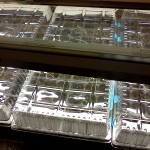
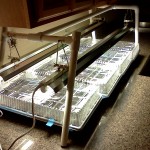
The bulbs themselves are about 4 foot long and when raised above the plants a few inches disperse enough light to hit at least half of the seedlings with “good enough” intensity.
The Results
We setup the seed starter on Tuesday, Feb 11th, Within 3 days we had several seeds sprout. I will be updating this table below with the sprout times of the various seeds we planted as I see them. We also did not plant all of the seeds, as some are not to be started until next month.
There is about 200-220 plants of the following types below:
| Day | Sprout |
|---|---|
| Feb 14th | Radish |
| Feb 14th | Chamomille |
| Feb 14th | Basil |
| Feb 15th | Spinach |
| Feb 15th | Marigolds |
| Feb 15th | Dark Green Lettuce Mix 1 |
| Feb 16th | Cabbage |
| Feb 16th | Snapdragons |
| Feb 16th | Cantelope |
| Feb 17th | Cherry Tomatoes |
| Feb 18th | Chives |
| Feb 18th | Sweet Peppers |
| Feb 18th | Watermelon |
| Feb 19th | Dark Green Lettuce Mix 2 |
| Feb 19th | Thai Hot Peppers |
| Feb 19th | Lemon Balm |
| Feb XXth | Roma Tomatoes |
| Feb XXth | Hot Peppers |
| Feb XXth | Nasturtium |
Today when I woke up, Justin excitedly told me that the seeds sprouted (literally overnight). He showed me the radishes, and as we looked, we saw the chamomille also sprouted. As I was writing this article a few hours later, I noticed the basil too. I really enjoyed seeing him excited about this!
He reminded me that we need to finish the aquaponics shelves in our 500 Gallon Aquaponics System so we have a place to put all these plants, and now I’m looking forward to the weekend so we can work more together on the large aquaponics system/greenhouse.
In 4-6 weeks we’ll be able to move most of these sprouts out and start the hardening process to acclimate them to the regular outdoor weather. I’ll have the tarpaflex cover for the greenhouse by then, and the grow beds will be ready for them too, so they should be off to a good start with a stable growing environment!
Who would of thought that growing things was so exicting and rewarding?

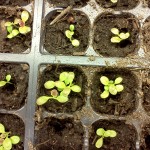
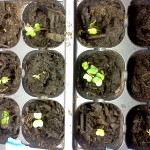
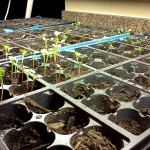
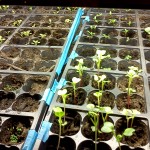
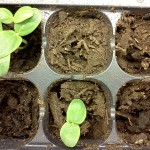
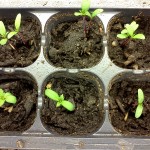
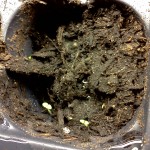
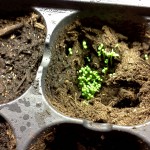
This page contains wide informations regarding the indoor growing system. Thanks for sharing all these information to the readers and these are really helpful for me. From this I got a new information about the lights used for this indoor system.